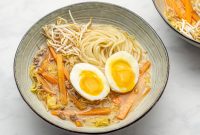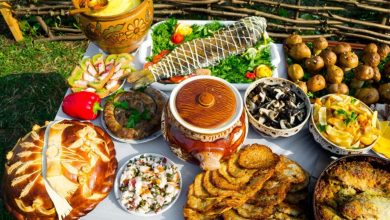Guide to Chinese noodles. Part 2. Rice, legume, starch and foreign
Chinese cuisine may seem like the result of a crazy experiment, but in fact it is a well-balanced system of combining taste and nutritional value. And this eternal search for a balance between tasty and healthy finds a worthy solution in the Chinese culinary tradition.
In the last issue, we talked about wheat noodles, today – about other types: rice, starch and even foreign. How to distinguish rice noodles from bean noodles, what is the most delicious dish of Sichuan cuisine and much more, read in the new issue of Yuliya Pashkevich’s project “Alchemy of Chinese Cuisine” – especially for Magazheta.
Fen , also known as mien is popular throughout China, but is especially loved in the south, in the provinces of Guangdong, Guanxi, Yunnan. Scientists agree that rice noodles appeared in China about two thousand years ago, around 259-210 BC. It was invented by the tribes of northern China, who at that time invaded the southern territories.
Since they were more accustomed to eating wheat, they did not like boiled rice, so they began to use it to make noodles. The traditional technology for making rice noodles is very unusual: not flour is used, as one might assume, but whole rice grains. To do this, it is necessary to soak the rice overnight, and in the morning pound with a mortar to a homogeneous paste. After that, it remains only to boil it for a couple and cut it. You can buy dried miffed in stores, but, of course, the taste and texture of homemade, fresh noodles are an order of magnitude higher.
Shahe fen – translucent, rather wide (1-2 cm) noodles, has a very delicate and silky koulan. Like all other rice noodles, Shahe fen retains a cloudy white color when cooked. These wide noodles were invented in the city of Shahe in Guangdong province 150 years ago. Shahe fen is versatile, as it has a neutral taste and is suitable for both frying and soups and cold dishes. Unlike other types of rice noodles.

shahefeng loses its taste when frozen or dried, so it is mainly sold fresh. When added to soup, they quickly soak, so try to eat the dish hot. Chaohefen ( stir-fried noodles with vegetables, usually cabbage or soybean sprouts, is an inexpensive and delicious dish that fully showcases the delicate taste and pleasant texture of these noodles.
The process of preparing Lingpa is rather unusual: first, the dough is kneaded from rice flour, after which it is placed in a container and “washed” with water until it becomes cloudy and saturated with rice starch. After that, the rest of the dough is taken out of the container and the starch water is left in a cold place overnight.
In the morning, the liquid should exfoliate, then the watery top is drained, and the bottom – thick, whitish and starchy – is poured into a mold in a thin layer, after which it is steamed for several minutes. The finished delicate and translucent “skin”[1] is cut into wide uneven stripes.
Starch noodles
Noodles made from pea or bean starch are called fens – “glass noodles”. The most delicious fens has been produced in Shandong province for more than three hundred years, and it is called longbow fens . Foreigners often confuse rice and bean noodles. Remember, when cooked.
rice noodle’s become white or milky, while bean noodles become transparent. You’ve probably seen “nests” of bean noodles in stores. Before boiling it, you need to soak the noodles for half an hour, after which you can already fry, or add to a variety of dishes: salads, fried spring rolls, tortillas or dumplings, in order to diversify the texture of their filling. One of the most delicious dishes where fens appears is a Sichuan dish, noodles are fried in a spicy bean sauce with pork mayo sheng she)
Diguafen sweet potato noodles, also known as fanshufen are wide, 1-2 cm, noodles made from yellow or orange sweet potato starch, and sometimes purple The composition includes only water and starch, so the nutritional value of such noodles is low, and there are fewer nutrients than in wheat. The taste of noodles made from purple or yellow sweet potato does not differ.

koulan is also identical, the classic QQ is resilient, elastic, jelly, slippery. Diguafen has no aroma, and with a good imagination, you can imagine the taste of ordinary potatoes. Despite such “lei sureness”, the Chinese dearly love it for its pleasant texture, so dishes based on such noodles can often be found in cafes or bought at any store. Diguafen is often used to make malatang soup or suanlafen sour and spicy noodles.
The author recommends trying this very simple, but incredibly tasty recipe:
You will need: 1 packet sweet potato noodles (usually 150-200 grams), 1 tablespoon sesame paste or peanut butter 2 tablespoons soy sauce, large garlic clove, ¼ teaspoon dried chili flakes, salt to taste, roasted sesame seeds or crushed peanuts for decoration.
Boil sweet potato noodles according to package instructions (usually no more than 8 minutes), drain in a colander and immediately pour into a deep bowl to serve. Add pasta, sauce, finely chopped garlic clove and mix. Let the noodles absorb the sauce for 1-2 minutes. Sprinkle top with sesame seeds or peanuts. Ready!
Other noodles
Recently, noodles of Japanese origin have gained popularity: soba or in Chinese qiaomaifen shirataki, she is also molimen and udo .
Moya fen – thin, round, whitish, sometimes with gray patches, often sold in the form of noodles. The noodles are made from the root of the konak plant, which is almost entirely water, so the noodles are sold in packs filled with liquid to prevent the product from drying out. In addition to water, the composition also includes a small amount of fiber.
which makes moil fen an extremely low-calorie product – only 9 kcal per 100 grams! The noodles have no taste, but the smell is present – a light “swampy” aroma, which is eliminated by rinsing the noodles for a long time before use. The texture is very similar to slightly undercooked bean noodles, quite dense, slightly crunchy. Good in malatang and low-calorie salads, paired with rich dressings that make up for the lack of flavor in the noodles.


